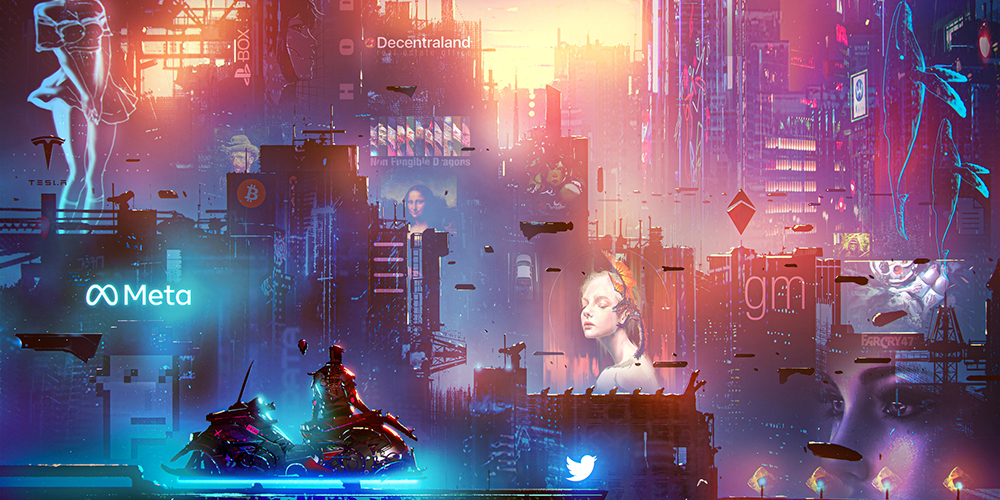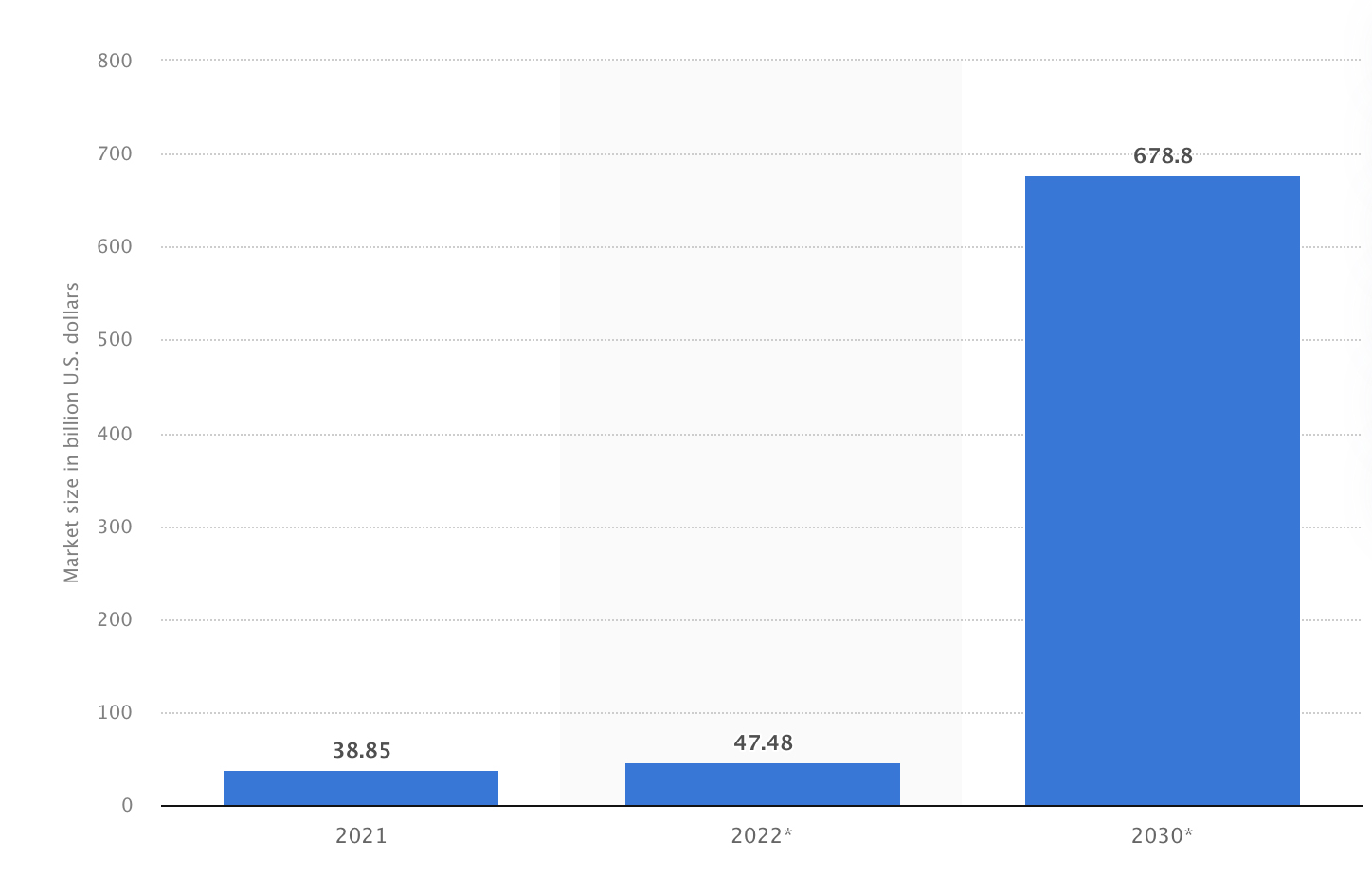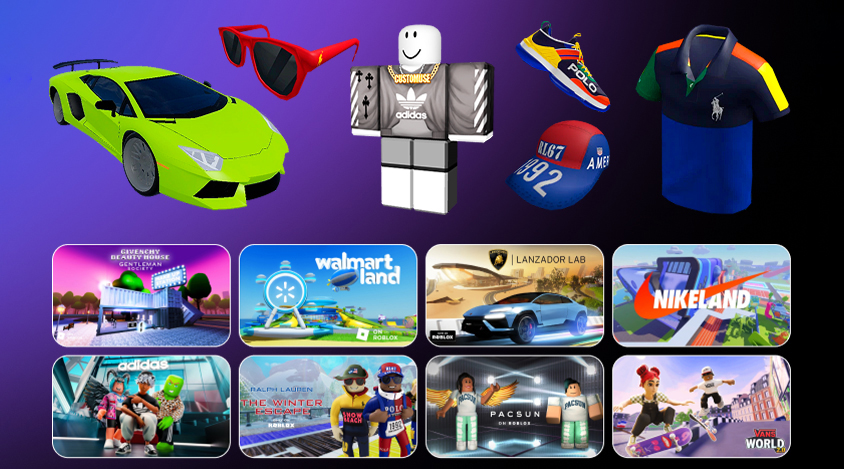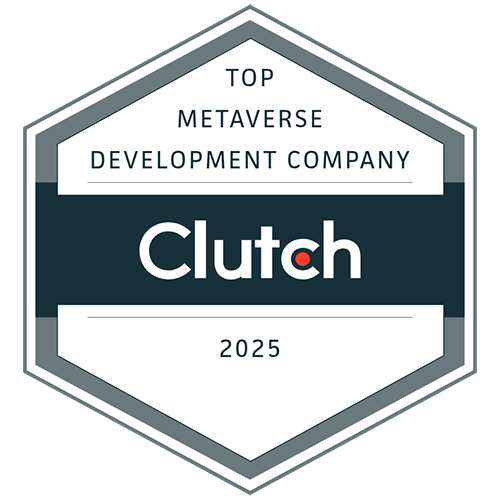With the surge of blockchain technology into the global tech scene, clarity on foundational concepts such as Web3 and the metaverse remains elusive. Both terms, despite their widespread excitement, are at the beginning of their development journey, with major corporations like Meta, Epic Games, and Nvidia actively advancing their practical applications.
Numerous decentralized applications (dApps) and metaverse projects are in progress, yet no Web3 development company can provide a precise vision of their future manifestations. Currently, discussions revolve around early-stage metaverses and Web3 applications, leaving the industry to rely on forecasts rather than concrete predictions.
This discussion aims to clarify the nuances of each term and the underlying technology, addressing who can benefit from these technologies and the mechanisms of their utility. Keeping up with our insights ensures you remain informed on technological advancements.
The comparison between Web3 and the metaverse highlights distinct yet interconnected domains. Web3, with its emphasis on decentralized protocols, offers a new layer of internet infrastructure, while the metaverse presents an immersive virtual environment for users. The interaction between Web3 and the metaverse underscores a synergistic relationship, where the decentralized nature of Web3 potentially enriches metaverse experiences with secure, user-governed environments.
The difference lies in their core objectives: Web3 focuses on decentralization across the internet, whereas the metaverse aims to create expansive, interactive virtual worlds. By understanding the interplay between Web3, the metaverse, and their respective contributions to digital innovation, stakeholders can better anticipate the trajectory of these pioneering technologies.
What Is Web3 and Metaverse? — Are They Synonyms?
The evolution of the internet is marked by significant technological advancements, transitioning through distinct phases that have fundamentally altered user interaction with digital content. Each phase introduced groundbreaking methods for engaging with online environments, setting the stage for the next wave of digital evolution.
The journey began with Web 1.0, characterized by static HTML web pages that provided introductory text and rudimentary images, marking the internet's infancy in the early 1990s. This era, defined by limited user interaction, transitioned in the early 2000s with the advent of Web 2.0. This new phase brought social media platforms like Facebook and YouTube to the forefront, transforming the internet with interactive experiences and visually rich content.
So, what is Web3? It emerges as a potential new phase of the internet, yet it is frequently misunderstood or conflated with the metaverse. The distinction between Web3 and the metaverse is critical to understand; they represent different technological paradigms. The metaverse offers an expansive, interactive virtual space, providing diverse experiences across gaming, digital marketplaces, and virtual workspaces. On the other hand, the Harvard Business Review defines Web3 as a blockchain-enabled internet iteration, emphasizing decentralization, permissionless access, and smart contracts.
The interaction between Web3 and the metaverse reveals a complex relationship. While they operate on distinct principles, the metaverse could potentially act as a catalyst for Web3's adoption by offering immersive experiences that leverage decentralized technologies. The Web3 metaverse discourse highlights the synergetic potential between decentralized internet protocols and virtual environments.
Understanding the difference between Web3, which advocates for a decentralized online ecosystem, and the metaverse, which aims to create fully immersive digital worlds, is pivotal for grasping the future trajectory of internet technology.
Web3 Overview: History Behind the Term

Exploring the nuances of Web3 reveals a multifaceted concept demanding thorough examination for full appreciation. Web3, as introduced by Ethereum's co-founder Gavin Wood in 2014, encapsulates a vision for an internet infrastructure that is:
- Decentralized, eliminating reliance on a central server for data storage or administration;
- Predominantly utilizing cryptocurrencies and non-fungible tokens (NFTs) for transactions and digital asset verification;
- Leveraging artificial intelligence for enhanced user experiences and automation;
- Integrating with the Internet of Things (IoT) to create a more connected digital world;
- Ensuring interoperability across various platforms and systems;
- Reconceptualizing data ownership and transfer mechanisms to empower users over corporations.
The ambition behind Web3 is to cultivate an online ecosystem where democratic principles and decentralization allow users, rather than large technology corporations, to own and govern digital spaces. Yet, the intricacies of Web3 extend beyond its foundational goals, suggesting a complex dialogue between emerging technologies and user sovereignty.
The comparison between Web3 and the metaverse often surfaces in discussions about the future of the internet. While both concepts are intertwined with the evolution of digital spaces, the difference lies in their primary focus. Web3 aims to redefine internet governance through decentralization and blockchain technology. In contrast, the metaverse is envisioned as a unified, immersive virtual environment enabling rich, interactive experiences.
The synergy between Web3 and the metaverse could redefine digital interactions, combining Web3's decentralized protocols with the metaverse's expansive virtual landscapes. This Web3 metaverse convergence promises a future where digital economies and virtual communities flourish under the principles of user autonomy and interconnectedness.
Understanding the relationship between Web3 and the metaverse and their distinct objectives is essential for navigating the next phase of digital innovation.
As the metaverse continues to captivate imaginations with its potential for creating fully immersive virtual worlds, Web3 provides the foundational technology to ensure these spaces remain open, secure, and user-centric. Therefore, the dialogue between Web3 and the metaverse is not just about technological advancements but about envisioning a new paradigm for the internet that prioritizes user empowerment and freedom.
Are Web3 and Web 3.0 the Same?
Numerous online sources, some boasting a semblance of authority, mistakenly equate Web3 with Web 3.0, yet a closer examination reveals clear distinctions. Web 3.0 represents the evolution of the internet into the semantic web, emphasizing intelligent, structured data as a progression from Web 2.0. This concept, part of Tim Berners-Lee's Solid project, diverges significantly from Web3, a term popularized by Ethereum's co-founder Gavin Wood.
Web3, as envisioned by Wood, pivots on blockchain technology, focusing on decentralization and user sovereignty over digital spaces. In contrast, Berners-Lee's Web 3.0, the next iteration of the internet, concentrates on the semantic web. This includes data interconnectivity and enhanced user privacy and control, aligning with Berners-Lee's original vision for the internet.
At the 2022 Web Summit, Berners-Lee, a pivotal figure in creating HTML, HTTP, and URI, articulated his reservations about Web3. He highlighted the frequent confusion between his concept of Web 3.0 and Wood's Web3, emphasizing that his vision centers around a semantic web that prioritizes data linking and user privacy, starkly different from the blockchain-centric approach of Web3.
The dialogue between Web3 and the metaverse further complicates this landscape, with each offering unique propositions for the future of digital interactions. While Web3 introduces a framework for decentralized internet ownership, the metaverse promises immersive virtual environments. The intersection of Web3 and the metaverse signifies a convergence of decentralized governance with virtual world-building, showcasing the potential for a new digital era.
Understanding the difference between the blockchain-driven Web3 and the semantic-focused Web 3.0 is crucial for grasping the nuances of internet evolution. This distinction also clarifies the ongoing debate around digital privacy, data control, and the structure of the internet's next phase. As discussions about Web3 vs. metaverse continue to evolve, it becomes evident that these technologies, although interconnected, cater to distinct aspects of our digital future, with Web3 laying the groundwork for a user-governed online ecosystem and the metaverse creating spaces for unprecedented virtual experiences.
Metaverse Overview: Insights & Analytics

Now, as we already know more about Web3, let’s answer the question: what is the metaverse? Even though metaverses (yes, there can be many of them) can rely on blockchain technology in most cases, they are just vast virtual environments delivering a broad spectrum of products and services to the end user. By the way, they can freely move around a metaverse’s digital space as if it were some kind of virtual reality application.
Well, metaverse developers pay careful attention to making these vast virtual worlds a happy place to be, with multiple ways to entertain oneself, buy or sell digital assets in the form of NFTs (non-fungible tokens), which are minted on a blockchain, allowing for smoother ownership transferring experience.

According to Statista, the global metaverse market revenue has increased from $38.85bn in 2021 to $47.47bn in 2022, with predictions to hit $678.8bn by 2030. Quite a promising forecast, isn’t it? Fortunately, these numbers hint at growing opportunities for tech companies of different sizes, so now is the best time to start building your own metaverse.

How Are Web3 and the Metaverse Connected?
In instances where virtual environments leverage blockchain technology, the metaverse and Web3 might appear as complementary facets of a single concept. With Web3's architecture grounded in decentralized applications, smart contracts, distributed ledger systems, cryptocurrencies, and non-fungible tokens (NFTs), any metaverse incorporating these elements edges closer to embodying Web3 principles. Consider the emerging proto-metaverses such as Fortnite or Roblox as illustrations of this convergence.
Examining the similarities and distinctions between these digital universes sheds light on their unique characteristics. Fortnite, for instance, emerges as a proto-metaverse, yet it hasn't integrated blockchain technology into its infrastructure as of now. On the other hand, Roblox represents a metaverse game that embraces blockchain technology akin to Decentraland. These platforms, while not fully developed metaverses, hint at future expansions that could introduce a broader range of activities for participants.
Thus, the metaverse has the potential to evolve as an extension of Web3's ideology, particularly when its iterations begin to harness NFTs, cryptocurrencies, and decentralization. However, it's entirely feasible to conceptualize a metaverse independent of blockchain technology, reflecting the strategic direction, business objectives, and consumer inclinations of the entity behind it.
The interplay between Web3 and the metaverse underscores a shared trajectory towards more immersive, decentralized digital experiences. Despite their differences, the integration of Web3 elements within the metaverse games, such as Roblox and Decentraland, illustrates a blurring of lines, suggesting a symbiotic relationship. This connection not only highlights the technical possibilities but also the philosophical alignment between decentralization and immersive virtual spaces.
Recognizing the difference between the blockchain-centric Web3 and the broad, experiential domain of the metaverse is vital for understanding their potential impact on digital culture and economics. As these technologies continue to mature, the fusion of Web3 principles with metaverse experiences promises a dynamic evolution of how we interact, transact, and exist within digital realms.
Web3 vs Metaverse: Key Differences
As already mentioned, Web3 is about decentralization and more secure ownership proven or transferred using smart contracts, such programs written to validate and approve transactions taking place on a blockchain automatically. This method of managing decentralized ownership is considered risk-free, automated, and faster.
The primary difference between Web3 and metaverse is that the former is a philosophy when the latter can or cannot be one of this philosophy’s manifestations. Hence, you can use the technology touching upon the metaverse for business, either with or without addressing blockchain. There’s no need to dive deeper into answering the question of what is the difference between Web3 and metaverse, inasmuch as the meaning is simpler than it seems.
So you can build a metaverse either using blockchain or not, but what you end up with is a full-size virtual world where you are able to integrate third-party services, arrange an online playground, sell virtual real estate for NFTs, or open a crypto marketplace — everything without leaving your metaverse. The audience will no longer have to close your app and open up another for other activities as your product is going to serve as an all-in-one solution.
How the Industry Is Already Using the Metaverse and Web3
We’ve already talked about how some companies make use of the metaverse in one of the previous sections. What about Web3 projects? Here are some of the use cases.

DeFi. Decentralized Finance is one of the most frequent manifestations of the Web3 paradigm since the distributed ledger system facilitates more advanced cybersecurity protocols, which is a big game changer for fintech products.

Blockchain-based video games. Entertainment applications like Axie Infinity or Alien World can be examined as the brightest representatives of the genre. The technology under the hood allows for ensuring the play-to-earn model for players.

Metaverse. Guess what? The metaverse is indeed a practically lucrative application of Web3. So you shouldn’t google “metaverse vs. Web3” anymore because these phenomena aren’t about the fight — they are created to bring profit and value for stakeholders.

Decentralized Autonomous Organizations (DAO). Wait a minute. Should decentralization mean that there are no groups of people behind the steering wheel? Correct, but here’s the catch. They are online communities ruled by the members themselves.

Cybersecurity infrastructure & privacy. One of the best use cases of Web3 projects presupposes using blockchain technology to improve cybersecurity and privacy on the web. Users will feel more comfortable sharing sensitive information.
Web3 and the Metaverse — Forecasts
Web3 and the metaverse are two revolutionary technologies expected to shape the future of the internet. They offer a new way to experience the web, with a more immersive and interactive experience. As you already know, Web3 is a decentralized platform that will enable users to access content without relying on centralized servers. In turn, the metaverse is an open virtual world where users can interact with each other in a 3D environment.
These technologies have been gaining traction over the past few years, and experts believe they will become even more popular in the coming years. As these technologies become more widely adopted, it’s beneficial to gain insight into what potential use cases we may see in the near future and how they could shape our online experience.
Research claims that companies already vote for the metaverse as it helps solve issues (39%), enhances creativity (37%), allows people to travel remotely (37%), and increases tech literacy (34%). Interesting insights, aren’t they? Web3 projects are to be the industry standard, with more corporations like Meta or Nvidia pushing their limits forward.
If you want to enter the metaverse as soon as possible, here’s a quick piece of advice. Look for a metaverse development outsourcing company that resonates with your corporate culture and brand identity. You’ll be one of the pioneers of the tech underlying Web3, which is almost inevitable. In the near future, all companies will be employing blockchain, so the privilege will be in the hands of those who start sooner.
How Can Program-Ace Help You Embrace Web3?
Program-Ace is a custom software development company proficient in metaverse creation and working with Web3 projects of almost any complexity. If you’d like to step into the world of next-gen technologies and offer something innovative to your audience, developing a dApp of any kind is the best of both worlds. You embrace digital transformation and satisfy the continually growing demand of your audience, which is a huge deal in today’s business.
Contact us for more in-depth information about how Program-Ace can assist you in your ambitions to develop Web3 projects or build the metaverse either using blockchain or without it.






















